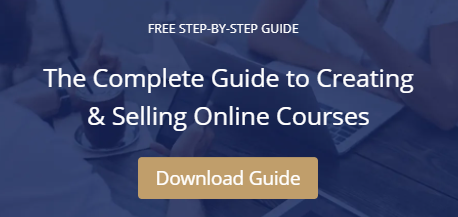As an author, publishing your first book is a big milestone. But how do you continue to engage your readers past the launch?
Using online courses is a great way to connect with your audience beyond a book launch. They can provide your readers with the tools to go from insight to action, making your content even more impactful.
Best-selling author Jeff Goins discovered the power of online courses early on in his business. Since writing multiple books and companion courses, he’s grown his community, impact, and revenue as a result.
If you’re an author wondering how to leverage online courses in your business, keep reading! This article is the first in a series of interviews with best-selling authors and industry experts on how to connect your book to an online course for greater reach and revenue.
Check out the Book to Course Expert Talks and sign up
to receive all the talks straight to your inbox!
In this interview, we sat down with Jeff Goins, author of The Art of Work, to learn how he’s created online courses and leveraged them to monetize his book content. As the creator of the successful Tribe Writers community and Tribe conference, we also heard the strategies he’s used to build his brand and community since day one.
Watch the video below for the full interview with Jeff Goins. You’ll learn how to create a course that complements your book, and strategies for building a thriving community.
Why Online Courses
Long before Jeff hit the best-seller lists, he started off like many other writers – battling anonymity through consistent blogging, and self-publishing an e-book.
In 2012, he began blogging regularly with the goal of chronicling the seemingly mysterious journey of becoming a professional writer. By sharing the ups and downs of the journey, what worked and what didn’t, he grew a sizeable following. Soon enough, he had amassed over 10,000 email subscribers and many writers were reading his blog daily.
“I got started with online courses when I realized that I could better serve my audience and earn revenue by breaking down the steps of what I learned, and show people exactly what they needed to do.”
– Jeff Goins
Jeff openly shared his process for growing an audience and becoming a published author in his first e-book. But when he found that people kept emailing with the same questions, he realized there was an opportunity to serve them further: his readers wanted someone to show them how to do things in detail, in addition to hearing the stories and advice already available in the book.
With this knowledge in-hand, Jeff began to connect his books to courses. In his book, You Are a Writer (So Start Acting Like One), he included a link to a sales page with information about an online course he planned to create. After collecting emails for six months and gaining enough interest, the idea for his course was validated.
Jeff created a comprehensive course version of his book, covering his entire process for getting published and making a living as an author. Between the book and accompanying online course, Jeff made $150k in sales by the end of the year. This marked the beginning of the Tribe Writers community, spawning related books, courses, training and coaching services.
Since then, Jeff has connected many of his books to online courses.
“What I will often do is create a custom online course to go even deeper on the topic. This can be positioned as a bonus or a mini upsell, where readers can further unpack concepts through videos or other lesson styles.”
– Jeff Goins
To hear more examples of how Jeff connects his books to courses, his sales funnels, and the impact they’ve had on his business, watch the video above!
Lessons for validating and creating your online course
If you’re wondering where to start in creating your first online course, make sure you remember this one important lesson from Jeff’s story: validate there is a need for your course BEFORE you create any content.
There’s nothing worse than spending your time creating content nobody wants and launching your course to zero sales.
Jeff validated that there was an interest in his online course by having frequent conversations with his audience. Before he had created a single lesson for his course, hundreds of writers opted in with interest to take his future course on becoming a published author.
If you’re just starting to build your audience, don’t skip this step! It will be even more important for you to find ways to engage your target audience and minimize your assumptions about what they want to learn.
Here are a few tips from Jeff’s own story for you to follow suit.
Listen to your audience
Jeff’s readers continued to send him emails asking for more details and advice on the same topics, even after reading through the how-to’s and concepts in his book.
If you notice you’re asked the same questions over and over, even after covering the topic in your own book, there’s a good chance you may have an opportunity to serve your readers through an online course. Monitor all your interactions with your audience, whether they’re over email, social media, or in person. Take note of any repetitive questions or pain points that surface.
Related article: For more tips on how to gather feedback to validate your online course topic, read this article on 5 Ways to Validate Your Online Course Concept.
Draft an outline
In Jeff’s book, The Art of Work, he explored the idea of how to find your purpose by including examples and stories to help readers discover what they are meant to do. In creating the outline for a course to go alongside the book, Jeff began with the end in mind – he focused on giving readers a practical tool to activate the concepts and stories in the book off the page.
“There are seven parts in the the book (The Art of Work). I had initially created seven podcast audio files to go along with it. When I realized that people wanted to go even deeper, I decided to take the material and convert it into a course. I broke each chapter into a module as the outline, and created my content from there.”
– Jeff Goins
If your goal is to create a complementary course alongside your book, aligning your book chapters to online course modules makes it easy for students to follow along with the practical steps.
Get live feedback
There are many ways you can gather feedback to validate your course. Jeff found success testing initial pieces of his course content in live training sessions. Between webinars, workshops and one-on-one’s, he gathered live feedback on his training content and format which helped expedite his course creation process.
“Start with a framework, get it in front of a live audience, and get feedback as quickly as possible. Then you can turn your outline into an online course with the right materials, knowing what will work best, like video lessons, worksheets, or guides.”
– Jeff Goins
Don’t be afraid to sell
If you struggle in knowing how to position your offer or worry about appearing too salesy, know you’re not alone. Jeff offered some tips around how to show up honestly.
Lead with the benefit. While people like buying things that will help them, they don’t like being sold something. When selling to your audience, aim to be as transparent as possible.
If you’re running a webinar for example, explain upfront what you’ll teach for 45 minutes, and then what product you’ll talk about in the last 15 minutes. Setting expectations helps take the pressure off you, and the listener. Focus on building trust throughout the process, being transparent with what you’re offering, and who you are.
“Stepping out into a different personas doesn’t work well, just be who you are. We are less likely to trust people we feel are putting on an act. Tell people your goal, what you’re offering, and what they’ll get out of it.”
– Jeff Goins
Growing Your Community and Influence
Since publishing his first few books and courses, Jeff has built a thriving community of Tribe Writers. If you’re just starting out in building your audience as an author, hearing Jeff’s origin story may help. Here are some tips on building authority and influence in your space.
1) Be consistent
When Jeff started blogging in 2012, he knew that in order to rise above the noise he would need to commit for the long-haul. So, he set himself a goal – for two years he would show up every day and put in a full effort to grow consistent readership on his blog, or he would quit.
For a year he published a blog post every single day. This drew initial interest and created a sense of trust between his growing audience.
2) Practice in Public
As his community started to grow, Jeff realized that people still didn’t know who he was outside his own corner of the internet. To break out of anonymity, he started to look for opportunities to publish his work elsewhere. He calls this ‘practicing in public’.
“No one will care as much about your work as you do. Think of your efforts as practicing in public, not marketing. My blog is practicing in public in front of my audience. Do your creative work in public, and you’ll create opportunities for new people to find you.”
– Jeff Goins
Jeff started writing guest posts for other sites and doing podcast interviews, rapidly growing his list as a result.
Whatever your area of expertise, think about how you could demonstrate elements of what you do in other people’s communities, tapping into their audience.
3) Grow a community, rather than an audience
Rather than trying to grow an audience, Jeff suggests going one step further to grow a community, or tribe.
In the words of Seth Godin, a tribe is defined as having the following elements: a group of people connected to a shared interest, each other, and a leader.
With this in mind, growing an engaged tribe doesn’t require thousands of people. It may, in fact, be a relatively small group of people who are all bought into the same idea. Kevin Kelly describes this as your 1,000 true fans – those who are galvanized behind your message and are keen to evangelize on your behalf.
Perhaps your method for connection is your blog, discussions, or email. Regardless, the power comes in emphasizing the shared identity.
One of the ways Jeff cultivated this sense of shared identity was giving his tribe a name. Early on, Jeff noticed that the Tribe Writer name stuck, and cemented the community as it continued to grow.
“One of the best ways to grow a community is to find ways to connect people to each other through a shared identity. There is something very powerful about giving that shared identity a name. It gives the community a sense of purpose and belonging.”
– Jeff Goins
In thinking about how to define the values and shared interests for your own community, here are a few things to consider in the process:
- Identify the aspiration of your audience. If the aspiration is to become debt-free for example, communicate this aspiration as a key objective as being part of the group.
- Draw a finish line. What is the shared process that people need to follow, and what does reaching their goal look like? Describe how that finish line feels in detail, and what they can expect along the way. Your goal is to help people shift their identity from where they are now to one that represents their end state.
- Wrap an identity around the group. This may mean choosing a name or co-creating a set of values. The goal is to create something that feels special and unique to those in the community, while still being visible and open for the rest of the world to join.
Related article: Want to know how to strategically build your community and brand? Check out this complete guide on How to Build a Personal Brand.
4) Be honest
Finally, Jeff reiterated how honesty is the best policy as you grow your profile as a leader in your space.
“Be honest about where you are in the journey. Show your failures, be vulnerable. More often than not, it will endear you to your audience. Maybe not everyone, but your job is to create something for someone, not for everyone.”
– Jeff Goins
Connect with Jeff at goinswriter.com, or on Twitter @JeffGoins.
Want a step-by-step guide to creating your first online course? Download our free guide and get started today!







